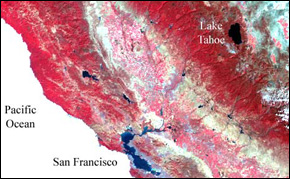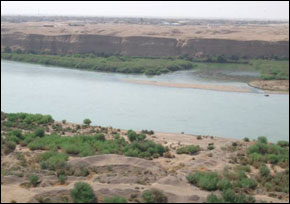Study: NASA Shows World’s Water is Warming, Buoy Data Confirms in Great Lakes
In some northern regions, lake temperatures are increasing more than air temperatures.

Researchers from NASA’s Jet Propulsion Laboratory have studied 167 large lakes around the globe using thermal infrared satellite imagery and have found that global lake temperatures increased more than one degree Celsius on average over the last 25 years due to a warming climate.
Simon Hook, one of the authors of the NASA study, told Circle of Blue that higher temperatures can disrupt ecosystems. Even small changes in lake temperatures can cause toxic algal blooms or major shifts in the natural balance.
“The warmer the lake, the greater the possibility that non-native species can be introduced,” Hook said. “Fish and plants have adjusted to a particular environment–a temperature change provides a window for invasives to get a foothold.”
Hook said the lakes research will continue in several directions. He wants to expand the number of lakes studied, while working on more detailed studies of particular lakes where a lot of warming is taking place. He also hopes to use the lake data to test the accuracy of climate models by looking backward at which models came closest to the observed conditions.
Hook and his colleague, Philipp Schneider, found an average increase of 0.45 degrees Celsius (0.81 F) per decade, but some lakes, especially those in higher latitudes of the Northern Hemisphere, experienced warming at a rate of 1 degree Celsius (1.8 F) per decade. The largest warming recorded was in northern Europe, followed by Siberia, Mongolia, and northern China, with slightly weaker trends in southeastern European regions such as Kazakhstan and the Black and Caspian seas. Warming was weaker in the tropics and the Southern Hemisphere.
Summer nighttime temperatures were used to avoid satellite complications due to iced-over lakes and cloudy skies, and measurements were taken from the point farthest from shore to prevent interference from land effects. Lakes chosen for the study were 500 square kilometers (193 square miles) or larger.
The results of the study are largely consistent with the expected effects of global climate change. And, in the case of the Great Lakes, where warming trends were slightly lower than the southwest U.S., the global results match data gathered from buoys on the surface of Lake Superior, said Jay Austin, a physics professor at the University of Minnesota-Duluth.
It takes significantly more energy to change water temperatures than air temperatures, Austin explained in an interview with Circle of Blue. Because of that, water temperatures are a more stable way of measuring long-term climatic change, he said.
Water plays an important role in moderating the global climate. The oceans have absorbed much of the increased heat over the last few decades, with the resulting thermal expansion–not glacial melt–being the primary cause of sea level rise to this point.
Austin, who works with the university’s Large Lakes Observatory, compared water temperature to a control knob that affects interactions between a lake’s biological, chemical, and geological components.
“By taking this big knob,” he said, “and suddenly turning it up significantly–-we’re talking several degrees Celsius over the last three decades, not a small change–-by turning that knob, it’s not entirely clear how the system is going to respond. It’s one of the things we’re starting to look at with numerical models.”
Source: NASA
Brett writes about agriculture, energy, infrastructure, and the politics and economics of water in the United States. He also writes the Federal Water Tap, Circle of Blue’s weekly digest of U.S. government water news. He is the winner of two Society of Environmental Journalists reporting awards, one of the top honors in American environmental journalism: first place for explanatory reporting for a series on septic system pollution in the United States(2016) and third place for beat reporting in a small market (2014). He received the Sierra Club’s Distinguished Service Award in 2018. Brett lives in Seattle, where he hikes the mountains and bakes pies. Contact Brett Walton










If deep water lakes are warming , and we are finding very active earthquake and volcanic activity, and the air is not warming the water and seems to be out of sync with the lakes warming.
We should go to the bottom of the lakes and see if its the earths core that is heating up causing these changes. Like any doctor look at all the symptoms.